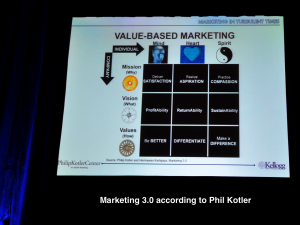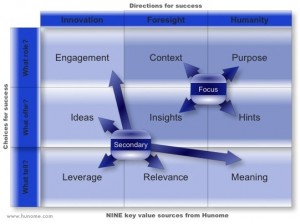Purpose and value – a company perspective
If you spent some time visiting several Fortune 500 web sites, how many of those do you think would clearly state their purpose and value to humanity? How many would have people in their brand somewhere? How many would talk about the passion they have for making the world a better place and how their actions bring that about?
I did that one year ago and there are some but not many. Mostly I found that those that have people in their brands and language do not have a ‘purpose’ statement. About ten years ago I did the same sort of study when I was with Nokia and found that a number of Japanese companies had a long term view and something like a ‘purpose’ statement – what was their role in this world, what benefit to humanity where they here to bring about.
The main objective of the company was to design and create innovative products, which would benefit the people. http://www.sony.com.au/section/sonysstory
This is not a mission statement, i.e. how to conquer some hill, but why do it anyway. Nor is it a vision, what could it all look like in some years’ time, if we all rally and make it happen (strategy – how). The focus is on the why.
One could say that all companies have people in their minds and brands to some extent: Facebook – making it easy to connect with friends, Google – making all things findable on the net [used to be: making it easy to find things on the net] and so on. There are many however for whom the purpose and product have disconnected because the ‘product’ is so entrenched in the society. The question of value to humanity is no longer considered to be of importance. I’d say the car industry has fallen into that trap and the banks just keep ignoring us, except for yet another credit card offer.
About one year ago I created a little 3×3 matrix, as one does, to try and articulate the value that the company, Hunome, I am working on, will bring to its company customers and in some ways also to the individual members. That image is called “nine value sources from Hunome”.
My image and argumentation got a bit complex and my attention had to go elsewhere, so it has not yet been fully fleshed out, however, the point of the model is that knowing more about humanity, or ‘what makes us tick’, allows companies to better articulate their purpose but it does many other things too. Not to worry it’ll get improved before any presentation
The vertical axis depicts a company’s actions: What role? What offer? What tell? These are vision [including own role and the ecosystem one needs to get stuff done], product and story respectively. The horizontal axis depicts the types of knowledge and input from which value could be sparked. The nine squares depict the sources of value from Hunome.
The argument goes something like this. If we know more about what makes people tick we can better articulate a purpose that resonates, not just with what’s on pulse, is there one, but also what’s in those deep veins of humanity. That knowledge gives a company hints about what to offer, not to expect direct answers from humanity knowledge to what products to make but hints, which a company needs to filter through their purpose, ability and the resources and means available to them. This humanity knowledge gives meaning for the stories told about the purpose, how the hints match the products, i.e. how seriously this company takes the input about people.
Knowing about people is the most fundamental, the most faddish and the most infuriating element of inputs at times. The fundamental part has to do with the stable aspects of being human even if each individual travels through change, through their life stages. For example we can guarantee that love, grief, joy and sadness are part of human existence. The faddish element has to do with the manufactured change, created for commercial interests and to give us some diversion when the going gets tough. The infuriating bits have to do with the fickleness and variability of it all. Although I love that, but in business it is cause for flummoxation. [flummoxed and vexation]. What works one day no longer does the next so some bravery is required in making decisions about products, services and stories, but lack there of is a sure way to oblivion eventually. Humanity knowledge leads to meaning that resonates with human hopes, dreams and even fears, hopefully alleviating the latter.
Foresight is the next direction to search for inputs for success. Foresight provides a company with the context, within which the purpose is played out, checking out the assumptions, are they still valid and adjusting the resources, means and visions to suit the changing elements, yet pivoting around the purpose. Insights are the nuggets that are directly useful to what the company offers as a response to the findings [context, hints] and relevant to its purpose. These four elements are where Hunome input is at its most useful first. The secondary elements are closest to taking action and are often the result of further deliberation in how a company wishes to translate the inputs to action. Foresight provides relevance to the types of stories the company tells about its longer term.
Innovation is a means for success closest to the company’s current day activities. Most innovation happens within a set context, which means that it is close to home so to speak, it is stated in the terms of specific problem solving, we all do it. Engagement is at the intersection of innovation and ‘what role’. A company keeps rethinking its means to its purpose, in the context of present day and with whom that purpose can be achieved. If two companies have similar purposes, driven with similar thinking about people, and their forward looking contexts are similar, then they are able to agree on engagement in a joint ecosystem relatively easily and not confuse each other or their audiences along the way. Innovation gives ideas for what to offer and provides means to leverage the other innovation squares for the near term stories.

Then about two weeks ago on Twitter I was pointed [cannot remember who )-: ] to Philip Kotler’s [marketing guru] value-based marketing 3×3, which reminded me of my model. There are differences but I think lots of similarity as well. Both are interested in creating value and being meaningful.
In particular I like the last row of Kotler’s model: Be Better, Differentiate and Make a Difference. Now, shouldn’t every company aspire to make a difference? The reality is however that there are many who aspire to just barely be number three or four or five or ….. Making a difference is a mindset, weaved into the values of the company. To me ‘making a difference’ has been a fundamental way in which I view things like competition, benchmarking and categorisation. If you know your purpose, you understand the humanity interest drivers behind it and you understand the future direction and context of your actions then drilling into competition, or benchmarking or needing desperately to fit into a known category become less important. Yes you still need to do some of that to contextualise yourself for others but that is not what drives your intent, your product decisions and who you play with.
Wouldn’t it be nice if all companies had a purpose statement, something which clearly let’s us know in what way they look to make this a better world for us humans, and our living environment :-)?
My tweets
Posts on…







